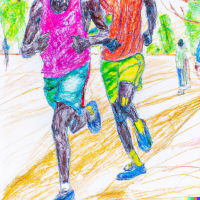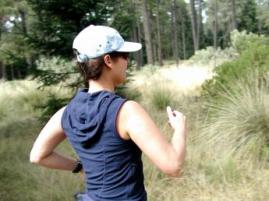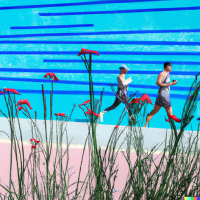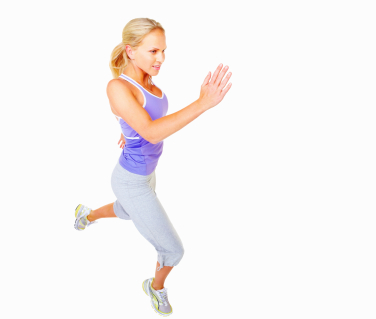Iliotibial Band Syndrome - How to Fix Your ITB
Iliotibial Band Syndrome. Try to say that ten times without hurting yourself.But having to say it is indefinitely better than dealing with it.
Iliotibial band syndrome (ITB syndrome) is an overuse injury which happens to many of us throughout our running career.
I have had to deal with my own fair share of ITB problems. So, what I will share with you on this page is a bit of my own story, causes, prevention and treatment:

What is iliotibial band syndrome
ITB syndrome is an overuse injury to the outside of your leg.
The iliotibial band is a ligament that runs from your hip to your shin on the outside of your thigh.
When this band gets tight, it can start causing some issues. Many of us feel it because the rubbing of this band on the bones on your knee causes friction.
And too much friction causes inflammation (nice word for PAIN).
Others, like me, have got more of a very tight feeling running on the outside of the leg, sometimes inflamed, sometimes just tight.
How do you get iliotibial band syndrome

I first encountered ITB syndrome when I was preparing for my first marathon. I was running very consistently. And very strongly. Pushing the mileage up further and further.
For me, it was definitely a mileage thing.
At one point during training I started feeling tightness on the outside of my left leg, just above the knee. Almost like a hard ball was forming. This ball of tightness sometimes caused some inflammation, but mostly it was just this tight feeling... until marathon day...
The first 25k (15 miles) of my marathon were uneventful. Exactly at pace the kilometres were ticking over quite easily. Until suddenly it was there.
The pain on the outside of the knee...
I regale this story quite often. With running friends only, non-runners will think it is deadly boring!
But you know what my first thoughts were? I thought to myself:"Look, I am already well over half way. You have got this. Sure, it hurts a little. But there is only 17k (11 miles) to go. It will be fine..."
Let's just say that about 5k (3 miles) later my perspective on that had changed radically.
The outside of my knee was hurting so much, that I had to change my gait to some type of wobbly walk/run. I lost minutes and minutes of time in that last part, because the ITB pain was so severe, I could barely run anymore.
How can you prevent iliotibial band syndrome
Now you know what is causing ITB it is almost too easy to answer the question on how you can prevent it... alright I'll do it for you!

All of these prevention ideas constitute the "sound and sensible" approach. It includes what we should do... And sure, at times, we follow all of this guidance and more. And some of us are old and wise enough and we have learned from our mistakes and can avoid big problems most of the time.
But you know how it is. When you are training hard and pushing yourself, you are always balancing the risk of injury with getting more out of your training.
So, let's move on to treatment options. After all, most of you will not be really interested in the contents of this page, until you suddenly have this pain on the outside of your leg of knee and google your way to a solution....
How can you treat iliotibial band syndrome
When you find out you have ITB syndrome, how can you treat it?
Yes, I am sorry, but you will have to give that iliotibial band of yours a bit of a rest. So less or no miles. Icing the painful area can reduce inflammation.
Do not continue your normal running routine. Do not be a hero and ignore the pain. You'll make things worse and run the serious risk of making your ITB pain a chronic injury. And that's something you really do not want.
Some of us find we get some relief out of the foam roller or a massage. Now, the ITB is a band. It is not a muscle that can be massaged. But a massage therapist would generally concentrate on the muscles around the ITB. Because it is generally the muscles around the ITB that are causing the problem.
I have found that foam rolling both front and back of my legs rather than the outside, can help provide some relief.
Although rest, ice and massage is a sensible first step, real treatment starts with strengthening the upper legs, particularly the glutes.

I know it is not running. And believe me, I have been there. Needing to cut back on my running and more or less slumping into a rut... But I have also done the opposite and moved to the exercise bike with enthusiasm. And you know what? It's not running, but it helps. It helps maintain that fitness and supports your mental health. And once you are able to fully run again, you'll be happy to know that you continued exercising and have not lost much fitness at all! Check out my cross training for runners page.
Now, on strength training. When you are running seriously, I have no doubt in my mind that you can benefit from adding a strength training routine to your week. And when you have ITB problems, I would double down and say that you absolutely have to do strength training!!
You need to build stronger legs. Stronger glutes particularly. A good set of exercises to do every day for about 15-20 minutes or so would include:

Strength training is super important. Check out the Strength Training for Runners page for all the information you need for a strength training routine that complements your running.
Too many hills? Too much track running in the same direction? Do you need other running shoes or orthotics? Do you need to cut back your mileage? Were you not doing strength training?
You owe it to yourself to be a bit critical here. You can't take some rest, whack some ice on it and then continue where you left off. Try to make some productive changes that will help you prevent problems going forward!
After a (short) rest period, ease into your running again. Take your time to get back to where you were before your injury.
More Rigorous Treatment Options
Now, from what I have seen and heard over the years of talking to many different runners who have had some ITB problems, is that sports therapists will generally prescribe all of the above before doing anything else.
However, for completeness, I will include more drastic treatment options that might be considered by some therapists:
As a totally last option, you can have surgery done. Most runners are not happy with the results of this because it gives them "floppy knees".
I certainly hope you recognise you have ITB syndrome in an early stage so that rest, ice, massage and strength training can help sort you out.
ITB syndrome is a sign you are doing something wrong. So while treating it, think, be critical and realise what it is you could do to improve your running.
And if you hadn't quite accepted it yet, I hope this page provided some additional argumentation of why you should add strength training to your routine!
Home > Running Injuries > Iliotibial Band Syndrome


